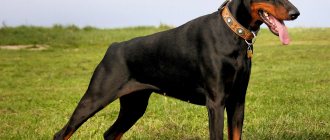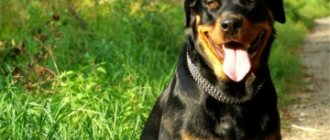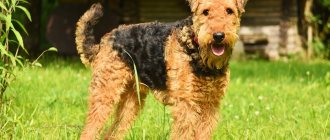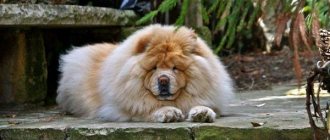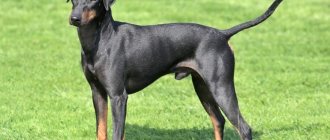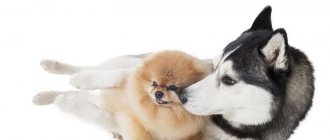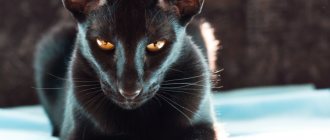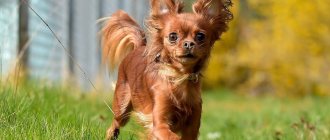The main features characteristic of the Rottweiler dog breed:
- It is distinguished by a developed mind, self-esteem, and increased endurance.
- Large and muscular, has powerful jaws. A dog’s attack is difficult to repel even for a trained person.
- Does not tolerate heat well, thanks to its thick undercoat it is not afraid of frost, and is tolerant of pain.
- Requires the firm hand of a strict leader with a strong character.
- Disadvantages include laziness, desire to dominate, love of sleeping in the master's bed, willfulness, stubbornness, and cunning.
- Does not tolerate violence.
- Able to independently assess the situation, make a decision and act with lightning speed.
- Athletic, requires increased activity and long walks.
- Needs training exclusively under the guidance of a professional, otherwise he will grow up aggressive and uncontrollable.
- Cannot exist without service, physical and emotional stress.
- He has an excellent appetite, is almost omnivorous, and therefore prone to obesity.
- Susceptible to genetic, cardiovascular, skin diseases, eye diseases, joint dysplasia and bloating.
In the city of Rottweil (Germany), which gave the name to the breed, a bronze monument to the valiant and faithful dog was erected in 2007.
Apartment Dweller
The Rottweiler is a large dog, but it can be kept at home. However, the animal will need a lot of space to live. In small apartments it will be difficult to miss a large dog.
This can stunt the Rottweiler's development. For example, his socialization. The Rottweiler's job is to protect its owner, so it is always suspicious of strangers. It's hard to keep your dog in place if guests are too close.
Where can I buy
Kennels selling Rottweilers are represented in large numbers in Russia and abroad:
- My Universe (Nizhny Novgorod, Russia);
- Rottwesthouse (Ekaterinburg, Russia);
- Rus Arraks (Moscow region, Russia);
- TAI FOKSTROTAS (Vilnius, Lithuania).
The price for a puppy without a potential show career is 12,000-18,000 rubles. If the owner is ready to purchase a dog for future breeding, the price rises to 20,000, but if the puppy’s parents were titled champions, the cost increases to 60,000-90,000. The cost of show-class Rottweilers starts from 150,000 rubles.
Rottweilers require a special approach to training, as they have strong natural instincts. However, with proper upbringing, they will become affectionate and obedient pets, ready to do anything to protect their owner and family.
A dog should have its own corner
In the apartment, the Rottweiler needs to be allocated places for sleeping and resting, feeding, and toileting. This must be done in advance in order to immediately show the puppy the boundaries of what is permitted and accustom him to the regime. The baby must know where, when and what to do.
It is better to choose a place for the dog to sleep and rest in a secluded corner, where it will not interfere with the movement of household members. Place a bedding or an old blanket there. Do not make the sleeping area too soft, otherwise the animal will develop bedsores. It would be good if the bedding had pillowcases that could be changed when dirty.
In order for the dog to be comfortable, its corner should be light and warm, without drafts or dampness. However, the Rottweiler should not be placed near radiators or in direct sunlight.
While the puppy is small, the toilet is placed nearby and is taught to use it from the first days the baby appears in the house. When your dog can go outside, teach him to go to the toilet during walks.
It is also necessary to set aside a specific place for feeding and teach the Rottweiler to eat at the appropriate time. You can familiarize yourself with the dog’s nutritional characteristics in the article “What to feed a Rottweiler.”
History of Rottweilers
It is believed that Rottweilers are descendants of the Roman Molossian Danes, who took part in military campaigns and battles in gladiatorial arenas. As stated above, Rottweilers are believed to have originated from Rottweil, a German city. Due to the appearance of the animal, it can be argued that the breed was formed thanks to the Swiss cattle dog - the Appenzeller Mountain Dog.
Since Rottweil was a center where livestock trade was active, these dogs were used as labor. Animals transported cargo and were excellent protectors.
Did you know? The proceeds from the sale of livestock per day were trusted to be transported to Rottweilers, tied to the body of the animal and sent home, since even the bravest robbers were afraid to approach these dogs.
At the time when the railway began to transport this specific cargo, which happened in the 19th century, the Rottweiler simply became an unnecessary breed. Thanks to the National Rottweiler Club of Germany, this breed was preserved.
Fresh air is the key to health
The main condition for apartment living is regular walks. The domestic Rottweiler lacks sunlight, fresh air and exercise. Turning a guard dog into a lazy fat dog is not fair to the breed. Moreover, Rottweilers are prone to obesity.
Walks with the puppy are short - half an hour a day. Do not overload your baby’s fragile body with special training. For a puppy, running around the park is enough.
When the baby turns one year old, regular trips increase to one and a half hours. If desired, the dog can be walked longer. Visit special dog parks. There the Rottweiler will be able to get the necessary physical activity by overcoming an obstacle course: barriers, ladders and others.
Origin of the breed
According to legend, the ancestors of Rottweilers are dogs of Roman legionnaires, protecting people and driving cattle. The animals bore some resemblance to Neapolitan mastiffs.
Rottweilers were bred to help farmers and were intended to protect livestock. They received their name from the German city of Rottweil, located in the Rhine Valley. Cattle fairs were held there. Subsequently, brave and quick-witted animals began to be involved in police service, used as guides and rescuers.
The breed standard was officially approved in the early 20s of the 20th century, at the same time the German Rottweiler Club was formed. The courage and power of these dogs was appreciated by dog handlers, and the breed became widespread.
Bite protection
The Rottweiler is exactly the kind of dog that needs to be muzzled while walking. This accessory will not allow the animal to pick up dirty objects from the ground, which will protect it from poisoning. Also, a muzzle for a Rottweiler will help to avoid conflict situations with passers-by - many people are afraid of large dogs.
There are many types of muzzles. Suitable for Rottweiler:
- metal mesh;
- closed leather muzzles;
- leather “baskets”;
- plastic;
- bridles.
Tail docking
Today, many breeders are arguing whether it is necessary to dock a Rottweiler’s tail or whether this is an optional procedure.
Why dock?
Today there is no need to dock the Rottweiler's tail . This operation is performed only to improve the dog’s appearance. There is an opinion that an undocked tail visually lengthens the body of the animal, making the appearance disproportionate. Most breeders are against surgical intervention, believing that it is cruelty to animals.
Interesting! In some countries, Rottweilers with undocked tails are of great value at exhibitions. Although docking up to two vertebrae at the base does not go beyond the standard.
In some cases, tail docking is a genetic necessity. After all, a tail twisted into a ring does not meet the standard.
At what age?
Tail trimming of a Rottweiler is required no later than 6 months . Anesthesia will be required as this is a very painful procedure. After which the pet will require post-operative care.
Next in the photo you can see what a Rottweiler looks like with a tail.
General characteristics of muzzles
The mesh of the metal muzzle is made of nickel-plated wire. Some meshes may have a leather lining to protect the Rottweiler's short coat from abrasion. These muzzles are durable and do not require special care. The mesh does not make breathing difficult, but eliminates the possibility of bites.
However, the mesh cannot be used in winter - the Rottweiler's lips and tongue may stick to the metal. And in wet weather, the metal can become rusty. Due to leather inserts, diaper rash often appears on the dog's skin. During training, you run the risk of injury from being hit by a metal muzzle.
Closed leather muzzles can completely protect passers-by from Rottweiler bites. They are tightly fixed on the dog's face, leaving only the nose free. To prevent the Rottweiler's skin from suffering, the muzzle has holes for air ventilation. This muzzle is convenient in cold and rainy seasons. But in hot weather it is better to avoid it - the animal will not be able to breathe in it, sticking out its tongue.
Leather “baskets” are used in any weather. In it, the Rottweiler will breathe and drink some water with his tongue hanging out. He will also be able to pick up garbage from the ground. So the “basket” is only put on trained dogs who obey their owner unquestioningly. A few more disadvantages: leather “baskets” need to be constantly cleaned and lubricated with special oil. Over time, they become unusable.
Plastic muzzles are an excellent replacement for “baskets”. They are also used in any weather. At the same time, muzzles prevent dog bites and are easy to care for. But even here there are some drawbacks. Plastic can rub your dog's skin or crack at the wrong time.
For walks in public places, a bridle muzzle is suitable. It will securely fix the Rottweiler's mouth right in the middle, preventing its powerful jaws from opening. Wear-resistant and low-maintenance bridles are suitable for any time of year.
Puberty
If the owner plans to breed Rottweilers, then you should know everything about the puberty of these dogs.
Estrus
The first heat in Rottweilers occurs at the age of 8-12 months . After which it appears every 6 months. The duration of estrus is about 18-21 days.
Mating
Mating of Rottweilers is usually carried out on the territory of the male dog, since he feels more confident in a familiar environment. Dogs should be left alone, this will make them more comfortable. If dogs fail to breed, owners must help the process.
To do this, the owner of the male dog holds his pet by the stomach, and with the other hand directs the loop to the male genital organ. After several matings, the genitals of the bitch and the male are joined, which is called a “lock.” Dogs can remain in this state from several minutes to 1 hour. “Castle” indicates successful fertilization. If it was not there, even after the male ejaculated, the mating can be considered unsuccessful.
Pregnancy
The gestation period for puppies varies between 57-70 days . It all depends on the individual characteristics of the bitch’s body. The first half of pregnancy proceeds unnoticed, then the pet becomes lethargic and irritable. Closer to the birth, she begins to “build a nest”, trying to find the most comfortable place to give birth to puppies.
Childbirth
Childbirth is quite a difficult process for a beginner. If this happens for the first time, it is better to use the services of an experienced dog handler.
The birth of a Rottweiler should take place in a quiet, calm environment. No more than 2 people should be present. By the time of birth, the dog breathes frequently and shallowly, the first attempts appear, and it begins to sulk. When the first puppy appears, you should rupture the placenta, cut off the umbilical cord, leaving about 5 centimeters, shake out the water from the respiratory tract, and wipe it dry. Place the baby close to the mother so that he can latch on, then wait for the next puppy to appear.
Keeping a Rottweiler is not as difficult as it seems at first glance. This is a very smart, disciplined animal. The main thing is to provide the necessary living conditions, proper care and training. Then the family will receive not only a protector in the person of a pet, but also a faithful, devoted friend.
Street Dweller
Now let’s figure out whether a Rottweiler can live on the street. Living in the courtyard of a private house is an ideal option for a dog of this breed. The main thing is that the fence is high and strong, and the gate closes well. A sudden escape by a Rottweiler can lead to trouble. If a dog mistakes a passerby for an intruder, it will jump over a low fence and bite him.
However, a Rottweiler cannot walk around the yard all the time. An outdoor dog will need his own place. You cannot keep a dog on a chain; this will have a bad effect on its development and psyche. It's better to build an enclosure. You can do it yourself or hire workers. In any case, certain requirements must be met.
How to choose a puppy
Buying a puppy is not difficult, as Rottweilers are very popular. However, you need to be aware: when making a purchase based on an ad on the Internet or in the market, you can get a sick dog with an unstable psyche. There will be a lot of problems with such a pet in the future. This is why you should buy a puppy from a kennel with a good reputation. Savings in this case are inappropriate.
The cost of a small Rottweiler depends on the class:
- Pet class will be the most inexpensive. The dogs are not intended for participation in exhibitions, as they have some deviations from the breed standard. However, this does not in any way affect their working qualities. Such a dog will be a reliable guard and companion.
- Breed class has a wide price range. The most expensive in the class will be puppies from titled parents, winners of various exhibitions. Such individuals are intended for breeding.
- Show class, the most expensive. Puppies with ideal characteristics. These are future champions and excellent producers.
The Rottweiler is a specific breed. Even if you really like the way she looks externally, think about whether this dog is worth getting. It is ideal for those who lead an active lifestyle, athletes, as well as families of several people. Pensioners, women or weak-willed people who are unable to establish leadership over a very smart dog should not get a Rottweiler.
Comfortable conditions
The enclosure for a Rottweiler should be cozy. To achieve this, you need to correctly determine the place for it. Choose the driest area in your yard, preferably on a hill. Then, during rains, water will not accumulate inside the enclosure. It’s good if from the chosen place the dog can see most of the yard and the gate.
Consider the direction of the wind - on the side where it most often blows, the dog will be protected by a closed enclosure wall. Part of the enclosure should be in the sun, part in the shade. An important detail is the area of the enclosure. A Rottweiler will need a lot of space and ten square meters will be enough.
It is better to make the floor of the enclosure from concrete so that the Rottweiler does not dig his way to freedom. When pouring the floor, do not forget about a slight slope that allows water to drain - the enclosure must be dry.
If you plan to keep your dog in an enclosure in winter, then you need to lay sanded boards on the concrete. Don't worry, the Rottweiler can withstand up to twenty degrees of frost. However, in severe frosts it is better to take the dog indoors.
In order for the Rottweiler to have visibility, one or two walls of the enclosure must be barred. The mesh will not work - the dog will easily tear it and may break teeth or claws. The remaining walls can be made of brick, metal profiles or smooth wood.
It is better if the door is located in a lattice wall. It should open inward and have two locks: on the inside and on the outside. The roof can be made of slate or metal profiles, the main thing is that there are no gaps. Gaps between the walls and the roof are also not welcome.
Pet diseases
Rottweilers, like other dogs, can have health problems characterized by :
- bloating;
- osteochondrosis;
- diabetes mellitus;
- hip dysplasia;
- osteosarcomas;
- retinal dysplasia;
- progressive retinal atrophy;
- cataracts;
- rupture of the cranial cruciate ligament.
More rare diseases that occur in Rottweilers are the presence of:
- aortic stenosis;
- congenital hypothyroidism;
- atlantoaxial instability.
Important! Due to the fact that the Rottweiler is a fairly large and heavy dog, it may have problems with the musculoskeletal system. Puppies should not be overloaded with jumping and running. Considering that a dog matures at approximately one and a half years, only by this time the animal will complete its formation and become fully stronger.
House in a house
The outdoor Rottweiler spends most of its life in an enclosure. Therefore, you need to place a booth inside the enclosure, inside which the dog can rest and gain strength. The Rottweiler's kennel must be spacious enough for him to enter, turn around, lie down and stretch out. But not too big, otherwise the animal will freeze.
It is better to buy or make a booth from dry coniferous wood - it breathes but retains heat. If the Rottweiler will live in a kennel in winter, then it is necessary to make double walls with a layer of insulation between them. Don't leave any gaps.
It is better to raise the booth fifteen centimeters above the ground. For example, put it on the uneven bars. At the same time, there should also be no gaps in the floor. You can lay a rug or a thick layer of straw at the bottom of the booth.
In cold weather, the entrance to the booth should be covered with an old rug or tarpaulin. It would be good if the booth had a removable roof. This will make it easier to clean it up. And in emergency cases, it will be easier to get the Rottweiler out of it.
Description of the breed
The Rottweiler has a balanced constitution. The body is compact, proportional to the limbs. The average weight of dogs is 42-50 kg, height 61-68 cm for males, 56-63 cm for females.
Description of the breed:
- The limbs are wide, straight, with a strong base. The pasterns are well developed.
- The head is of medium length, the occipital protuberance is developed, but not protruding.
- The neck is strong and muscular. The croup is wide, of medium length. The back is straight and strong.
- The muzzle is slightly narrowed, ending in a wide lobe. The nostrils are round and widened. The rims of the eyes, lips, and earlobes are black. The cheekbones are clearly defined and emphasized by the color.
- The jaws are strong. Scissor bite.
- The ears are set wide apart, medium in size, triangular, cropped. Uncropped ones hang down to the middle of the cheekbones.
- The tail is straight, thick, docked.
Black and tan is the only acceptable color. Symmetrical red spots can be located on the paws, belly, throat, cheekbones; white spots are a breed defect.
The coat is coarse, hard, even, and of medium length. On the hips the fur hangs down more. The undercoat is inconspicuous, thick and dense. Thanks to such a “fur coat,” the Rottweiler will feel comfortable in any frost.
Clean and safe home
If you sprinkle dry sawdust on the floor of the enclosure, you can get rid of puddles and unpleasant odors. You need to replace dirty areas with clean sawdust at least twice a week. In addition, be sure to remove leftover food to prevent the spread of mold and mildew.
The booth needs to be treated for parasites. In summer - once a month, during the rest of the year - once every two to three months. Lysol or formalin are suitable for disinfection. The Rottweiler should not enter the kennel until the solution is completely dry.
Nutrition
The Rottweiler dog is an excellent eater, but is prone to gaining excess weight and overeating. On top of that, it has sensitive digestion. Therefore, the dog’s diet should be selected in such a way that the owners do not have to think about the diet for their four-legged companion.
It is important not to overfeed the animal and to be resistant to the dog’s sad and pitiful gaze directed at the chewing owner. Rottweilers can do this. And although the dog will never refuse a snack, you cannot follow his lead.
There is no need to talk about the correct combination of proteins-fats-carbohydrates, since this is obvious. But what are these proportions in terms of products? The basis of the diet is carbohydrates and proteins - buckwheat, rice porridge, as well as oatmeal, wheat cereals, beef and poultry meat, and sometimes, once a week, fish products, eggs, dairy products such as cottage cheese, natural yogurt and sour cream, vegetables in boiled and raw. The latter should make up a quarter of the daily diet.
Rottweilers rest after running
In addition to all of the above, puppies should be fed with mineral supplements that affect the strength of the ligaments and bone skeleton. The older the individual, the fewer times a day it feeds.
So, if a two-month-old Rottweiler licks the bowl four times during the day, then three meals a day will be enough for a nine-month-old puppy, and two meals a day will be enough for a completely adult dog.
It is worth making a list of prohibited foods, which will include salted, fried, smoked foods and sweets. In addition, legumes, milk, which causes eating disorders, long bones, potatoes, fresh baked goods, and indeed all baked goods are prohibited. Egg, millet and pearl barley are not recommended - they are digested very slowly and lead to bloating.
Fasting days will not be amiss - for adult pets they are arranged once a week. On this day, the dog consumes only water and lactic acid products. The diet of puppies, in principle, does not differ from the adult diet, with the caveat that new foods should be introduced gradually. It is not recommended to give meat earlier than 3.5 - 4 months.
Rottweiler obeys the command to lie down
The same can be said about the bones. Food should be at room temperature, fresh and taken at the same time, which will help develop a routine.
The owner is your best friend
If a Rottweiler lives in an enclosure, this does not mean that you can forget about him. Lack of attention from the owner and forced loneliness can have a bad effect on the animal’s psyche. The dog will either become depressed or become aggressive.
Regular communication with your dog contributes to its proper development. Feeding, playing, talking - it's wonderful. But the Rottweiler also needs to be released from the enclosure into the yard and even into the house. He must contact all family members. Only in this case will the dog know who and what to protect.
To maintain good physical shape, you need to go for walks outside the fence with your Rottweiler. Fresh air and sunlight strengthen the dog's immune system. And a long run in the park or in the forest helps her get rid of accumulated energy. When going for a walk, be sure to put a muzzle on your Rottweiler.
Now you know how to keep a Rottweiler. If you have anything to add to our article, share your opinion with us.
If you liked the article, please share it with your friends. Don't forget to like.
Content
- The main character traits of a Rottweiler: female or male?
- Rottweiler character
- Basic commands
- Raising a dog
In this article you will learn what features of character and behavior are inherent in the Rottweiler. After studying this information about the temperament and disposition of a Rottweiler at different ages, you will get an idea about the breed. Find out how the character of a bitch differs from the behavior of a dog. We hope our article will help you figure out which gender of puppy is best for you.

